39 separation of a mixture lab answers
600+ TOP Mechanical Engineering Interview Questions and Answers Thermal n is high for weak mixture and it decreases as mixture strength becomes rich. 38. How engine design needs to be changed to burn lean mixture ? Engine to burn lean mixture uses high compression ratio and the highly turbulent move¬ment of the charge is produced by the geometry of the combustion chamber. 39. Solved Exp.3: CHEM 1110 Lab. Exercise - Separation of a ... Many mixtures can be separated into their individual components by taking advantage of different physical properties of the components. Sublimation is the Question : Exp.3: CHEM 1110 Lab. Exercise - Separation of a Mixture 1 Name/Section/Date Introduction Mixtures may be homogeneous (e.g., solutions and colloids) or non-homogeneous (e ...
Solved Separation of the Components of a Mixture Pre-lab ... Transcribed image text: Separation of the Components of a Mixture Pre-lab Questions Before beginning this experiment in the laboratory, you should be able to answer the following questions. 1. Classify each of the following as a pure substance or a mixture; if it is a mixture, state whether it is heterogeneous or homogeneous: (a) concrete, (b) tomato juice, (c) marble, (d) seawater, and (c) iron.

Separation of a mixture lab answers
PDF Virtual Lab - Mixture Separation - Denton ISD Mixture Separation Virtual Lab. ... Answer the conclusion questions and turn your lab in by the date your teacher specifies. Good luck! Title: Mixture Separation Author: Northside ISD Created Date: 9/22/2015 10:59:42 AM ... Separations Lab Answers.pdf - Separation of A Mixture Lab ... Separation of A Mixture Lab Long answer: 1. Calculate the percent composition and percent error for all of the components of the mixture. 2. For each part, explain the separation technique and how each substance was isolated from the mixture. Discussion and Conclusion - seperation of a mixture The 0.35 grams of mixture that are missing can be accounted for as parts lost in the process of separation, meaning our percent yield for this experiment was 82.5%. When separating the solution chemically, the separation is possible because of differences in the way that each component of the mixture reacted with a given chemical.
Separation of a mixture lab answers. › lab_4 › manualLab 4 - Qualitative Analysis - WebAssign Then, a different test is performed to uniquely confirm the identity of each separated ion. In this lab, we develop a qualitative analysis scheme to separate and identify the components of a chemical mixture. The mixture will be composed of the iron (III) ion (Fe 3+), the barium ion (Ba 2+), and the silver ion (Ag +). › cell-separationCell Separation and Cell Isolation: Techniques, Methods ... Faster cell separation protocols are desirable if you need to increase your throughput and accomplish more with your time in the lab. Some of the fastest cell isolation kits can isolate highly purified cells in as little as 8 minutes. Ease-of-use contributes to the reliability and reproducibility of a cell separation method. Simple protocols ... learning.hccs.edu › faculty › janiceEXPERIMENT 11: Qualitative Analysis of Cations Part I: Separate a mixture of known cations: Ag+, Pb2+ and Hg 2 2+ into individual ions. By performing a series of tests, become familiar with reactions characteristic for each cation, and their results. Part II: Separate and identify individual cations in an unknown solution containing a mixture of two to three cations. PDF Separating the Components of a Mixture 1. Obtain an unknown mixture and record the unknown number on the lab report sheet. Then weigh the unknown mixture in a tared 150 mL beaker and record this data value (include all decimal places on the balance) on your report sheet. 2. Add 30 mL of deionized water to the mixture in the 150 mL beaker, while stirring continuously.
edu.rsc.org › experiments › separating-sand-and-saltSeparating sand and salt by filtering and evaporation Pour the sand–salt mixture into the beaker so that it just covers the base. Add about 50 cm 3 of water, or add water until the beaker is about one-fifth full. Stir the mixture gently for a few minutes. Filter the mixture into a conical flask. Pour the filtrate into an evaporating basin. Experiment 11 — Infrared Spectroscopy - Amherst Your goal in this lab is to identify the important IR absorptions that are characteristic of certain compound classes and functional groups. You will also be looking at the variations within groups of similar compounds, the effect of having two or more functional groups in proximity, and effect of isotopic substitution. Write the answers to the PDF Separating Mixtures and Solutions - ANSWERS Hand sorting: to separate a mixture by hand, one piece at a time. 2. magnetism separation method using a magnet to pull out metal pieces from a mixture. 3. flotation: separation method using water to float some substances while others sink. 4. filtration: separation method using a filter that retains large particles while letting smaller ones ... PDF Separation of a Mixture - Lab Manuals for Ventura College Separation of a Mixture Pre-Lab Assignment Before coming to lab: • Read the lab thoroughly. • Answer the pre-lab questions that appear at the end of this lab exercise. Purpose A heterogeneous mixture of iron (Fe), salt (NaCl), and sand (SiO 2) will be separated by physical means and the percent composition of each will be determined. Background
quizlet.com › 533201805 › chemistry-lab-midtermchemistry lab midterm Flashcards | Quizlet While pulling an empty beaker off the shelf at the beginning of lab, it slips out of your hand onto the floor. Closed-toe shoes While transferring a solution from a flask to a beaker, the solution accidentally spills down the front of the lab bench. Lab coat While picking up a buret, an unknown solution left by a previous solution drips onto ... PDF Name: Date: Lab Partner: Lab # 2: Separation of a Mixture Lab Partner: Lab # 2: Separation of a Mixture Chemistry 1 Separating a mixture by physical means has many important applications. For example, if a toxic chemical is spilled into a reservoir the EPA must have a means of extracting it so that the water is safe to drink again. In this lab you will be given a mixture of sand, salt, and iron filings. Chromatography, Distillation and Filtration: Methods of … Aug 18, 2021 · A mixture is defined as a physical combination of two or more substances that are not chemically combined. Learn about the types of mixtures and the methods for separating mixtures (chromatography ... PDF Chromatography Lab: Separation of Mixtures and Compounds ... 6. Start the separation by placing the paper into the solvent and also make note of the starting time. 7. The separation is complete when the solvent is within 1.0 cm of the top. While you are waiting, you need to read the information on the back of this lab. Answer questions 1-3 before moving to step 8. 8.
PDF Separation of a Mixture Lab - cbsd.org Lab Procedure Simplified o Separate the IRON using the bar magnet. o Mix the SAND/SALT with 20 rnL water in 250 mL beaker until the salt dissolves. ml: Lab Materials Glassware Other materials Hardware Lab Overview (cont.) o Then you will separate the salt from the sand.
PDF LAB - SEPARATION OF A MIXTURE - Quia LAB - SEPARATION OF A MIXTURE Chemists often need to separate mixtures of two or more substances. Because a mixture is a physical combination of materials, the components may be separated using physical changes. There are different ways of accomplishing such a process. One common laboratory technique involves distillation, where substances having
chemistry lab midterm Flashcards | Quizlet While pulling an empty beaker off the shelf at the beginning of lab, it slips out of your hand onto the floor. Closed-toe shoes While transferring a solution from a flask to a beaker, the solution accidentally spills down the front of the lab bench. Lab coat While picking up a buret, an unknown solution left by a previous solution drips onto ...
Orgo Lab Rutgers Spring 2021 Flashcards & Practice Test - Quizlet Mixture B is a mixture of Para-Cyanobenzoic acid and 2-Chlorophenol. Mixture C is a mixture of Para-Cyanobenzoic acid and 4-Nitrophenol. All mixtures are dissolved in methylene chloride a) Why would reacting Mixture A with an aqueous solution of NaHCO3 (sodium bicarbonate) NOT separate one substance from the other?
quizlet.com › 586549734 › orgo-lab-rutgers-springOrgo Lab Rutgers Spring 2021 Flashcards & Practice Test - Quizlet Mixture B is a mixture of Para-Cyanobenzoic acid and 2-Chlorophenol. Mixture C is a mixture of Para-Cyanobenzoic acid and 4-Nitrophenol. All mixtures are dissolved in methylene chloride a) Why would reacting Mixture A with an aqueous solution of NaHCO3 (sodium bicarbonate) NOT separate one substance from the other?
Separation of a Mixture lab Flashcards - Quizlet A mixture contains two or more compounds that... can be separated by only chemical means. can be separated by physical means. can never truly be separated. can be differentiated because they have particles of different size and/or color. can be separated by physical means
Separation of a Mixture Lab | Teacher instructions | #GoOpenVA Possible answers include: color, shape, size, texture Explain that sometimes the need to separate a mixture can be life and death- examples include separating pure water from contaminants or separating blood components for use in medicine.
Post Lab Number Two Separation of a Mixture - Nhi Chung ... When finding the mass of ammonium chloride and calculating the percentage of NH4CL, use this formula: NH4CL (grams of total grams of mixture) x 100. For a sand and NaCl, put them in a clean, small evaporating dish, add about 30 mL of water, heat and stir about five minutes.
PDF EXPERIMENT 2: Separation of the Components of a Mixture EXPERIMENT 2: Separation of the Components of a Mixture Name:_____ Post-Laboratory Questions and Exercises Due after completing the lab. Answer in the space provided. 1. The Department of Transportation uses a mixture of sand and salt to de-ice roadways in the winter. The mixture contains 8.35 tons of salt and 6.28 tons sand.
Lab 1-Separation and mixtures lab - DavidHonChemPer8 Place one gram of mixture in a filter paper. And place the filter paper in the flask 2. Put the mixture into the boiling water, allowing the salt to dissolve 3. Filter the salt water out, leaving the insoluble products sifted out 4. Measure the mass of the mixture. Subtract this number from the original total mass to find the mass of the salt. 5.
2 Lab Separation of a Mixture.docx - Google Docs A mixture can be separated by "physical" methods, that is, techniques that perform the separation without changing the chemical properties of the mixture's components. Let us consider some of the more common separation techniques that the student will perform during this lab experience: filtration and evaporation.
DOC Separation of a Mixture Lab - Henry County Schools You and your group of will develop a tentative procedure for a step-wise separation method to separate your mixture into its components. The compounds that will make up your mixture are Iron Filings, Sand, Salt, and Beads. You will have access to the following pieces of equipment: Aprons Goggles Water Hot Plate Paper Towels Beakers Funnel
Separation of a Mixture of Solids Lab Report - Separation ... Gather one of the clean, 100-mL glass beakers and place it on the scale to get the mass. Take the mixtures and place it from the white paper into a clean, 100-mL glass beaker. Put 50 mL of distilled water into the 100mL glass beaker.
300+ TOP Civil Engineering Interview Questions and Answers Why are separation membranes used between concrete pavement slab and sub-base? ... To achieve the perfect balance the test nails should always be loaded so that the ultimate soil/grout mixture with an upper limit of 80%. ... 100+ TOP Soil Mechanics & Foundation Engineering LAB VIVA Questions and Answers ; 300+ TOP Tunnel Engineering Objective ...
Chocolate Lab – Your Guide To The Chocolate Labrador Retriever Jul 29, 2021 · I have had a yellow lab that we lost to cancer but he was 9yrs old! We got him from a co-worker at the age of 4 he was my best friend. Till my wife surprised me for my birthday one year, about 3yrs after loosing my Buck, that was my yellow lab. She got me a chocolate lab (Bear) and he reminds me of Buck and in some weird way acts like Buck.
byjus.com › chapter-5-separation-of-substancesNCERT Solutions for Class 6 Science Chapter 5 Separation of ... The clear water was then poured off from the top. The process of separation used in this example is called decantation. 9. True or false? (a) A mixture of milk and water can be separated by filtration. (b) A mixture of powdered salt and sugar can be separated by the process of winnowing (c) Separation of sugar from tea can be done with filtration.
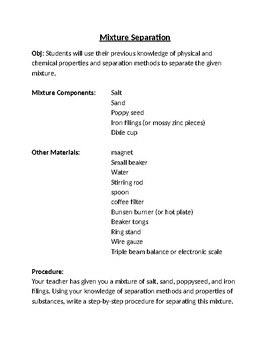
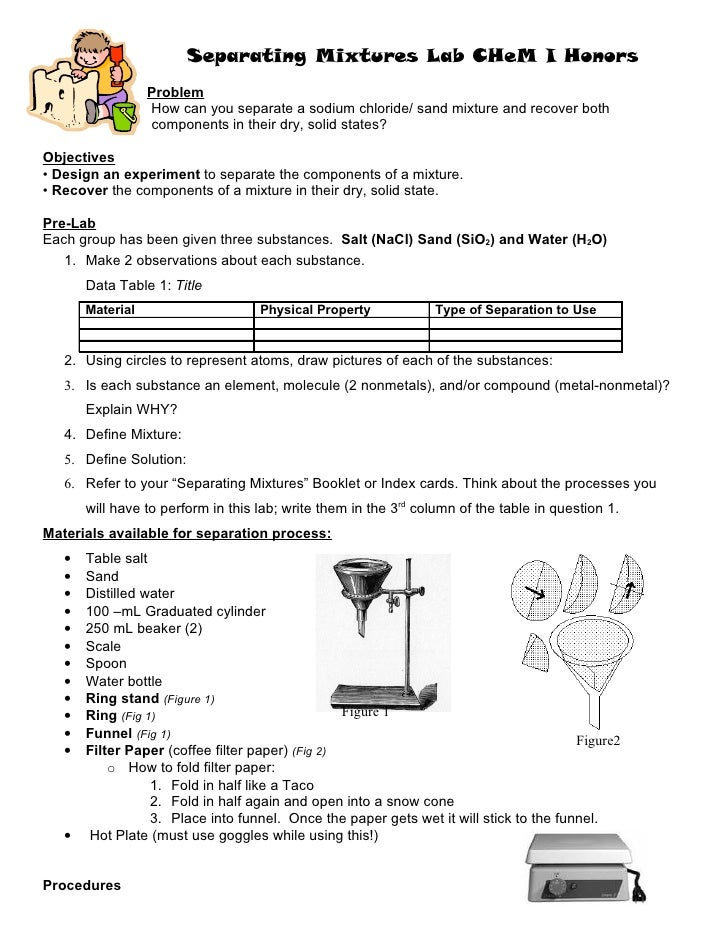

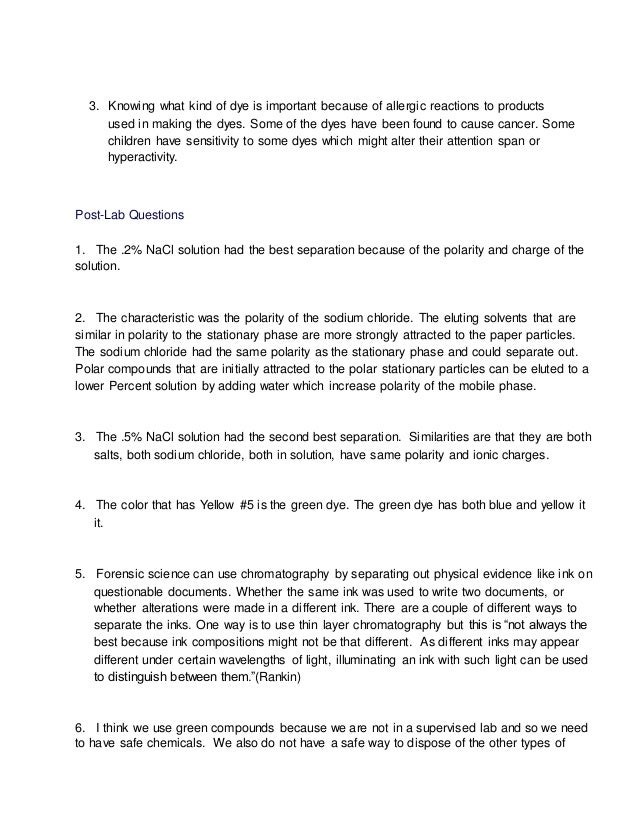




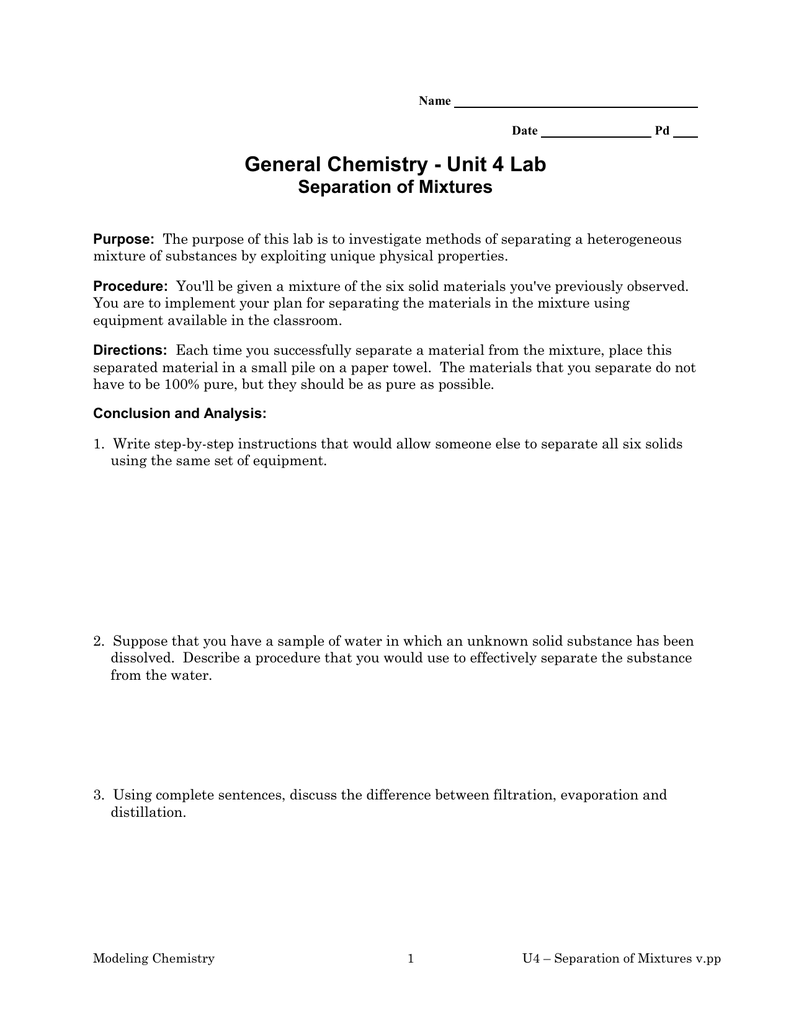
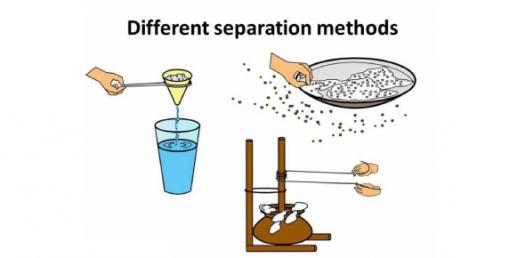


0 Response to "39 separation of a mixture lab answers"
Post a Comment